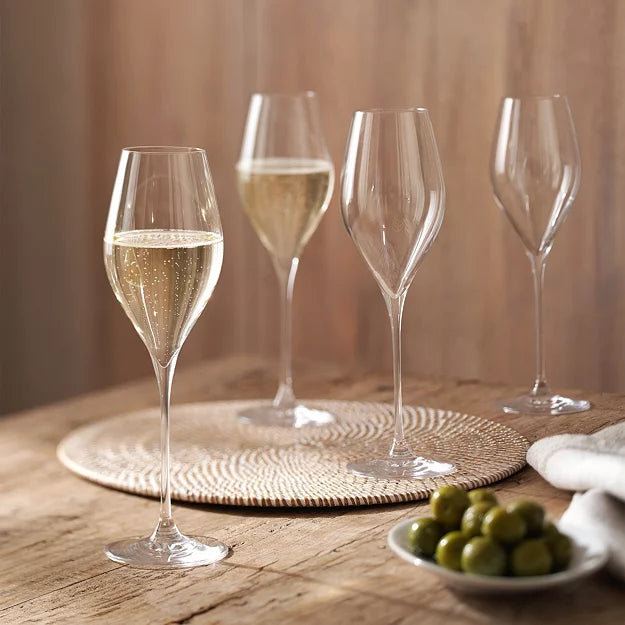Fun Facts You Didn't Know About Prosecco
Despite being one of the nation’s favourite tipples, we guarantee there’s a whole lot you don’t know about Prosecco – from its fascinating history to the unique varieties and the best ways to drink it.
1. It’s More Popular Than Champagne
Prosecco, the Italian sparkling wine, is the world’s most popular fizz. It sells more bottles than French champagne and Spanish cava combined. But it is a quite recent invention. Up until 2009 Prosecco was the name of a grape, mainly, but not only, grown in north-eastern Italy. Then it morphed into the name of a wine region and became a world-wide success story.
2. Only Ten Grapes Can Be Included
Prosecco was originally the name of a grape and a place, but once the wine’s popularity grew, more clarification was needed to avoid just anyone using the name. The prosecco grape was renamed ‘Glera’ in 2010, and must make up 85% of a wine for it to be labelled Prosecco.
As for the other 15%, only nine other grapes are allowed to make up this smaller percentage. These include Verdiso, Bianchetta Trevigiana, Perera, Glera Lunga, Chardonnay, Pinot Bianco, Pinot Grigio and Pinot Noir.
3. Different Areas Produce Different Prosecco
The extended Prosecco DOC area has very diversified soil; from stony to clayey or sandy. As such, the notes are generally less intense and persistent than DOCG, and can be more floral or more fruity depending on the soil.
4. It Has The ‘Goldilocks’ Of Bubbles
Particular about your fizz? Prosecco is also the perfect choice if you need your bubbles ‘just right’ – with different degrees of perlage to choose from. Opt for the the fully sparkling spumante (fully sparkling) if you enjoy strong bubbles, or frizzante (lightly sparkling) if you prefer a more gentle fizz.
The difference in bubbles comes through the making process: frizzante is more like a 'Soda Stream', whereas in a spumante the bubbles emerge through the second fermentation (sugar and yeast = alcohol and bubbles).
5. But It’s Not Always Bubbly
The Romans may have enjoyed Prosecco, but it wasn’t until the 19th century when Antonio Carpenè – Founder of the Carpenè Malvolti winery – subjected the still white wine to a second fermentation that Prosecco acquired it’s now lasting association with bubbles.
Still Prosecco – known as tranquillo – is still available today if you want to savour the wine’s crisp flavour, without the bubbles.
6. It’s Not As Sweet As People Think
Up until the 1960s, Prosecco was generally rather sweet – but, since then, production techniques have vastly improved, leading to the high-quality dry wines produced today. A standard glass of Prosecco has around 121 calories and isn’t too bad for your teeth – since the levels of residual sugar are still far below dessert wines – however, it may seem sweeter than it actually is due to the grape’s fruit-forward flavours.
Prosecco is now made in four different levels of sweetness: brut, extra dry, dry or demi-sec, with brut being the driest and demi-sec the sweetest. For the lowest sugar option, opt for a brut nature, which has no residual sugars (0-3g per litre).
7. ‘Aged’ Prosecco Isn’t A Thing
Unlike Champagne and other red and white wines, Prosecco doesn't ferment in the bottle, therefore it doesn’t improve with age. The crisp flavors of Prosecco are meant to be enjoyed as young as possible, while the acidity and fruit-forwardness are still fresh – consuming a bottle within a year of its vintage is ideal.
8. It Tastes Best In A Certain Glass
Prosecco is best served in a tulip style sparkling wine glass and served cold. The height and slenderness of the tulip glass is said to help preserve the bubbles, and the bulb at the top helps collect more of the floral aromas coming from the wine.
9. It's One Of The Most Versatile Wines With Food
You might not know it – but when it comes to food pairing, Prosecco is one of the most versatile wines around. It teams well with pretty much anything you’re planning to put on your plate: breakfast Mimosas with eggs, a glass with sweet treats and afternoon tea, an accompaniment to salty crisps and nuts, and ideal with a variety of dinners – refreshing the palette with creamy pastas and spicy curries, or mirroring the fresh taste of seafood and light salads.


